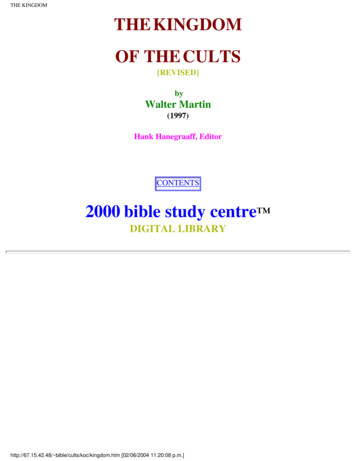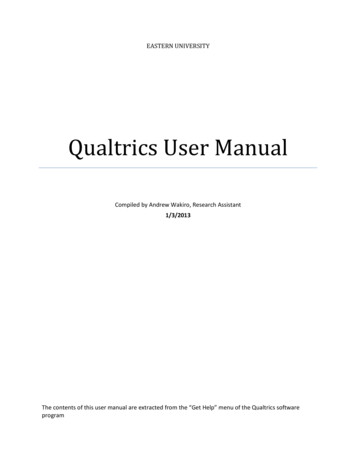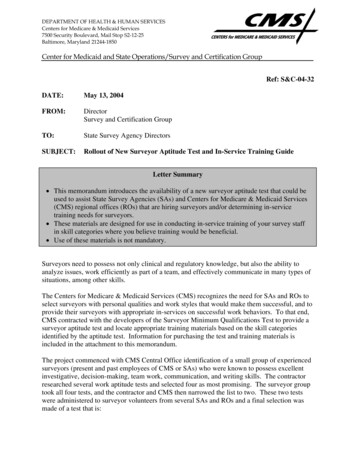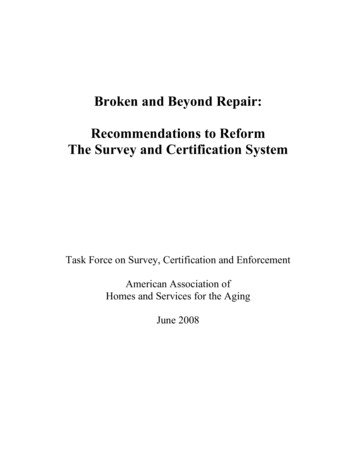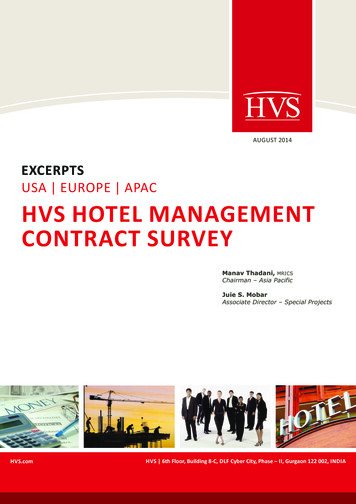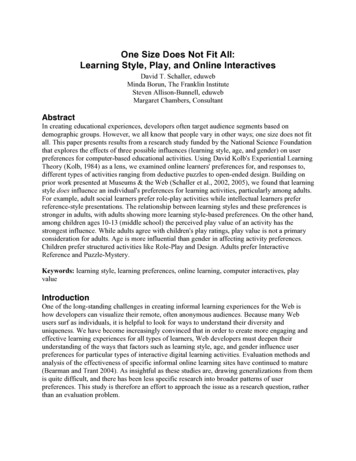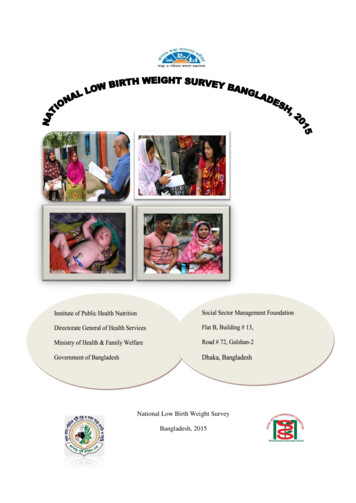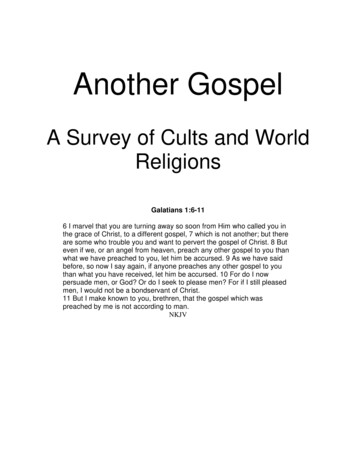
Transcription
Another GospelA Survey of Cults and WorldReligionsGalatians 1:6-116 I marvel that you are turning away so soon from Him who called you inthe grace of Christ, to a different gospel, 7 which is not another; but thereare some who trouble you and want to pervert the gospel of Christ. 8 Buteven if we, or an angel from heaven, preach any other gospel to you thanwhat we have preached to you, let him be accursed. 9 As we have saidbefore, so now I say again, if anyone preaches any other gospel to youthan what you have received, let him be accursed. 10 For do I nowpersuade men, or God? Or do I seek to please men? For if I still pleasedmen, I would not be a bondservant of Christ.11 But I make known to you, brethren, that the gospel which waspreached by me is not according to man.NKJV
Scripture quotations marked ANKJV@come from the New King James Version of the Holy Bible Copyright 8 1982.Used by permission of Thomas Nelson Publishers, Nashville. All Scripture quotations in these materials will comefrom the NKJV unless otherwise indicated.Scripture quotations marked AKJV@ are taken from the Holy Bible, King James Version.Scripture quotations marked ANIV@ are taken from HOLY BIBLE, NEW INTERNATIONAL VERSION7.Copyright 8 1973, 1978, 1984 by International Bible Society. Used by permission of Zondervan Publishing House.@Scripture quotations marked ANCV@ are taken from the Holy Bible, The New Century Version7. Copyright 8 1987,1988, 1991. Used by permission of Word Publishing.Scripture quotations marked ANLT@ are taken from the Holy Bible, New Living Translation, copyright 1996. Used bypermission of Tyndale House Publishers, Inc., Wheaton, Illinois 60189. All rights reserved.Scripture quotations marked ANASB@ are taken from the NEW AMERICAN STANDARD BIBLE7, Copyright 8 1960,1962, 1963, 1971, 1972, 1973, 1975, 1977, 1995 by The Lockman Foundation. Used by permission.Any spelling, editorial, grammatical, ortheological errors found herein are strictlythe fault of the author.Copyright 8 James G. Arthur 2000No portions hereof may be used in any Afor sale@or commercial publication without the expresswritten consent of the author.
As always, dedicated with all ofmy love and thanks to Debbieand Becky, the truly specialChristians in my life.
BibliographyBoa, Kenneth, Cults, World Religions and the Occult, USA: Victor Books, 1977, 1990.Braden, Charles S., These Also Believe, New York: MacMillan Company, 1949.Breese, Dave, Know the Marks of Cults, The 12 Basic Errors of False Religion,Wheaton: Victor Books, 1975.Geisler, Norman L. and Ron Rhodes, When Cultists Ask, A Popular Handbook on CulticMisinterpretations, Grand Rapids: Baker Books, 1997. This work is not dividedby chapters on cults but rather takes each verse of Scripture that the cults mayuse and discusses the various cults and the methods of defending orthodoxinterpretations.Gerstner, John H., The Theology of the Major Sects, Grand Rapids: Baker Book House,1960.Irvine, William C., Heresies Exposed, New York: Loizeaux Brothers, Inc., Bible TruthDepot, 1917.Martin, Walter, Rise of the Cults, Santa Ana, California: Vision House Publishers, 1955,1977.Martin, Walter, The Kingdom of the Cults, Minneapolis: Bethany House Publishers,1965, 1977, 1985. (I believe this book has also undergone a more recentrevision as of about 1998.)McDowell, Josh and Don Stewart, Handbook of Today s Religions, San Bernardino,California: Campus Crusade for Christ published by Here s Life Publishers, Inc.,1982.Christian Apologetics and Research Ministry, http://www.carm.org, a Christian site.ReligiousTorlerance.Org, http://www.religioustolerance.org, a secular site.In addition to these books for more general coverage, books on individual cults or
religions, or groups of organizations, will be considered in specific chapters with fullbibliographies in the footnotes.
Table of ContentsAmerica Today?!? . . . . . . . . . . . . . . . . . . . . . . . . . . . . . . . . . . . . . . . . . . . . . . . . . . . . . . . Page -1Examples and Consequences . . . . . . . . . . . . . . . . . . . . . . . . . . . . . . . . . . . . . . . . . . . . . . . Page -6Religion and Other False Doctrines . . . . . . . . . . . . . . . . . . . . . . . . . . . . . . . . . . . . . . . . . Page -14Who Are The Cults? . . . . . . . . . . . . . . . . . . . . . . . . . . . . . . . . . . . . . . . . . . . . . . . . . . . . Page -26Mormonism . . . . . . . . . . . . . . . . . . . . . . . . . . . . . . . . . . . . . . . . . . . . . . . . . . . . . . . . . . . Page -27Terminology of Mormons and Jehovah's Witnesses. . . . . . . . . . . . . . . . . . . . . . . . . . . . . . . . . . . . . . . . . . . . . . . . . . . . . . . . . . . . . . . Page -45Jehovah’s Witnesses . . . . . . . . . . . . . . . . . . . . . . . . . . . . . . . . . . . . . . . . . . . . . . . . . . . . Page -48Seventh Day Adventists . . . . . . . . . . . . . . . . . . . . . . . . . . . . . . . . . . . . . . . . . . . . . . . . . . Page -58Armstrongism . . . . . . . . . . . . . . . . . . . . . . . . . . . . . . . . . . . . . . . . . . . . . . . . . . . . . . . . . Page -72Church of Christ, Scientists . . . . . . . . . . . . . . . . . . . . . . . . . . . . . . . . . . . . . . . . . . . . . . . Page -77New Thought Movement . . . . . . . . . . . . . . . . . . . . . . . . . . . . . . . . . . . . . . . . . . . . . . . . . Page -84Unity School of Christianity . . . . . . . . . . . . . . . . . . . . . . . . . . . . . . . . . . . . . . . . . . . . . . Page -88Christadelphians . . . . . . . . . . . . . . . . . . . . . . . . . . . . . . . . . . . . . . . . . . . . . . . . . . . . . . . . Page -93The Churches of Christ . . . . . . . . . . . . . . . . . . . . . . . . . . . . . . . . . . . . . . . . . . . . . . . . . . Page -97Faith Healing . . . . . . . . . . . . . . . . . . . . . . . . . . . . . . . . . . . . . . . . . . . . . . . . . . . . . . . . . Page -100Roman Catholics . . . . . . . . . . . . . . . . . . . . . . . . . . . . . . . . . . . . . . . . . . . . . . . . . . . . . . Page -112Liberalism . . . . . . . . . . . . . . . . . . . . . . . . . . . . . . . . . . . . . . . . . . . . . . . . . . . . . . . . . . . Page -130Secular Religions . . . . . . . . . . . . . . . . . . . . . . . . . . . . . . . . . . . . . . . . . . . . . . . . . . . . . . Page -141Freemasonry . . . . . . . . . . . . . . . . . . . . . . . . . . . . . . . . . . . . . . . . . . . . . . . . . . . . . . . . . . Page -146The Way International . . . . . . . . . . . . . . . . . . . . . . . . . . . . . . . . . . . . . . . . . . . . . . . . . . Page -153-i-
The Unification Church . . . . . . . . . . . . . . . . . . . . . . . . . . . . . . . . . . . . . . . . . . . . . . . . . Page -155Scientology . . . . . . . . . . . . . . . . . . . . . . . . . . . . . . . . . . . . . . . . . . . . . . . . . . . . . . . . . . . Page -160Unitarians . . . . . . . . . . . . . . . . . . . . . . . . . . . . . . . . . . . . . . . . . . . . . . . . . . . . . . . . . . . . Page -164Judaism . . . . . . . . . . . . . . . . . . . . . . . . . . . . . . . . . . . . . . . . . . . . . . . . . . . . . . . . . . . . . Page -169Islam . . . . . . . . . . . . . . . . . . . . . . . . . . . . . . . . . . . . . . . . . . . . . . . . . . . . . . . . . . . . . . . . Page -176Black Muslims . . . . . . . . . . . . . . . . . . . . . . . . . . . . . . . . . . . . . . . . . . . . . . . . . . Page -183Baha’i . . . . . . . . . . . . . . . . . . . . . . . . . . . . . . . . . . . . . . . . . . . . . . . . . . . . . . . . . . . . . . . Page -187The Occult . . . . . . . . . . . . . . . . . . . . . . . . . . . . . . . . . . . . . . . . . . . . . . . . . . . . . . . . . . . Page -192Spiritism . . . . . . . . . . . . . . . . . . . . . . . . . . . . . . . . . . . . . . . . . . . . . . . . . . . . . . . . . . . . . Page -196Swedenborgianism . . . . . . . . . . . . . . . . . . . . . . . . . . . . . . . . . . . . . . . . . . . . . . . . . . . . . Page -199Theosophy . . . . . . . . . . . . . . . . . . . . . . . . . . . . . . . . . . . . . . . . . . . . . . . . . . . . . . . . . . . Page -201The Rosicrucian Fellowship . . . . . . . . . . . . . . . . . . . . . . . . . . . . . . . . . . . . . . . . . . . . . Page -204Satanism . . . . . . . . . . . . . . . . . . . . . . . . . . . . . . . . . . . . . . . . . . . . . . . . . . . . . . . . . . . . . Page -206Witchcraft . . . . . . . . . . . . . . . . . . . . . . . . . . . . . . . . . . . . . . . . . . . . . . . . . . . . . . . . . . . Page -209The Doomsday Cults . . . . . . . . . . . . . . . . . . . . . . . . . . . . . . . . . . . . . . . . . . . . . . . . . . . Page -214Eastern Religions . . . . . . . . . . . . . . . . . . . . . . . . . . . . . . . . . . . . . . . . . . . . . . . . . . . . . .Hinduism . . . . . . . . . . . . . . . . . . . . . . . . . . . . . . . . . . . . . . . . . . . . . . . . . . . . . .Janism . . . . . . . . . . . . . . . . . . . . . . . . . . . . . . . . . . . . . . . . . . . . . . . . . . . . . . . .Buddhism . . . . . . . . . . . . . . . . . . . . . . . . . . . . . . . . . . . . . . . . . . . . . . . . . . . . . .Sikhism . . . . . . . . . . . . . . . . . . . . . . . . . . . . . . . . . . . . . . . . . . . . . . . . . . . . . . .Zoroastrianism . . . . . . . . . . . . . . . . . . . . . . . . . . . . . . . . . . . . . . . . . . . . . . . . . .Confucianism . . . . . . . . . . . . . . . . . . . . . . . . . . . . . . . . . . . . . . . . . . . . . . . . . . .Taoism . . . . . . . . . . . . . . . . . . . . . . . . . . . . . . . . . . . . . . . . . . . . . . . . . . . . . . . .Shintoism . . . . . . . . . . . . . . . . . . . . . . . . . . . . . . . . . . . . . . . . . . . . . . . . . . . . . .Hare Krishna Movement . . . . . . . . . . . . . . . . . . . . . . . . . . . . . . . . . . . . . . . . . .Transcendental Meditation . . . . . . . . . . . . . . . . . . . . . . . . . . . . . . . . . . . . . . . . .Page -219Page -220Page -221Page -222Page -224Page -224Page -225Page -226Page -227Page -228Page -229-New Age . . . . . . . . . . . . . . . . . . . . . . . . . . . . . . . . . . . . . . . . . . . . . . . . . . . . . . . . . . . . Page -232New Age In A Nutshell . . . . . . . . . . . . . . . . . . . . . . . . . . . . . . . . . . . . . . . . . . . Page -241-ii-
The Progression of the Cults . . . . . . . . . . . . . . . . . . . . . . . . . . . . . . . . . . . . . . . . . . . . . Page -242Reflections . . . . . . . . . . . . . . . . . . . . . . . . . . . . . . . . . . . . . . . . . . . . . . . . . . . . . . . . . . . Page -243. . . If you want to know Jesus . . . . . . . . . . . . . . . . . . . . . . . . . . . . . . . . . . . . . . . . . . . . Page -249-Page -iii-
Matthew 7:15-2315 “Beware of false prophets, who come to you in sheep’s clothing,but inwardly they are ravenous wolves. 16 “You will know them bytheir fruits. Do men gather grapes from thornbushes or figs fromthistles? 17 “Even so, every good tree bears good fruit, but a bad treebears bad fruit. 18 “A good tree cannot bear bad fruit, nor can a badtree bear good fruit. 19 “Every tree that does not bear good fruit is cutdown and thrown into the fire. 20 “Therefore by their fruits you willknow them.21 “Not everyone who says to Me, ‘Lord, Lord,’ shall enter thekingdom of heaven, but he who does the will of My Father in heaven.22 “Many will say to Me in that day, ‘Lord, Lord, have we notprophesied in Your name, cast out demons in Your name, and donemany wonders in Your name?’ 23 “And then I will declare to them, ‘Inever knew you; depart from Me, you who practice lawlessness!’11All Scripture is quoted from The Holy Bible, New King James Version, (Nashville,Tennessee: Thomas Nelson, Inc.) 1982, unless otherwise noted.Page -1-
America Today?!?According to the Universal Almanac 1996,2 86% of the US population definesthemselves as Christians!Let us stand and cheer!!!!!!!!!!Of this group, according to the Almanac, 61% are Protestant and 25% are RomanCatholic.The Protestants break down as follows:TTTTTT34% Baptists20% Methodists13% Lutheran7% Presbyterian5% Episcopalian21% “others”According to the same Almanac, 2% of the US population is Jewish, 5% follow otherfaiths, and 7% are not affiliated with any religion.The break down in Canada is almost the same, based upon their 1991 census. 85% ofthe Canadian population defines themselves as Christian.TTTT54% Roman Catholic43% Protestant2% Eastern Orthodox2% “other”In Canada, the United Church of Canada and the Anglican Church of Canada are thelargest Protestant denominations.2J. W. Wright, Ed., The Universal Almanac, 1996, Andrews & McMeel, Kansas City,517; as quoted by http://www.religioustolerance.org.Page -2-
Worldwide, according to the 1992 Encyclopedia Britannica Book of the Year,3Christianity is the most widespread religion. Christians are put at 33.9% of theworld’s 1996 population, a figure that has been amazingly constant during the lasthalf of the twentieth century. In relative terms, the growth of Christianity over thepast 50 years has approximated the growth rate of the world’s population.Christianity competes with Bahai as the world’s largest religion. The Britannicafound significant Christian communities in 254 countries and territories, while Bahaiis present in 205. Islam comes in a distant third with 172 locations.4How did the statistics get to be so “Christian?” Many would rejoice over this “fact.”But a review of the breakdown shows that Christian includes Jehovah’s Witnesses,Christian Science, New Thought, Mormons, Spiritualists, psychic, and New Age. Alllumped under one umbrella. No wonder Christianity fares so well in these surveys.To the secular world (as represented, for example by ReligiousTolerance.org)Christianity is comprised of three main movements, the Gnostic Christians, thePauline Christians, and the Jewish Christians. The Jewish sect was headed by James, author of the Bible epistle, andincluded Jesus’s original disciples. It disappears before the end of the firstcentury. The Gnostic movement claims to have special and otherwise unknown secretknowledge (gnosis). Some were members of “mainline” congregations,others were not. The Gnostics were deemed to be “heretics” by the Churchand were suppressed. This leaves only the “Pauline Christians.” This is the “mainline” body ofcongregations, comprised largely of non-Jewish Christians. These groupswere “created” by Paul and his missionary co-workers. The Bishop of Romebecomes the recognized head of this group and Siricius (384-399) claims thetitle of Pope for the first time.In 1054 the Christian centers in Rome and Constantinople form aschism, over control issues and in particular the meaning of the LastSupper. The church at Rome eventually becomes the Roman CatholicChurch. The Church at Constantinople becomes the Eastern OrthodoxChurch.3As quoted by http://www.religioustolerance.org.4Greg H. Parsons, Exec. Dir., U.S. Center for World Mission, Pasadena, CA; quoted inZondervan News Service, 1997-Feb-21, as quoted by http://www.religioustolerance.org.Page -3-
The Roman Catholic Church is not truly formed, however, until theReformation beginning in 1517. One must remember, whether you arereading secular history or a good history of the Christian church, thatthere is only one church from the Apostles to the 1054 schism. Whilethe early church has many “centers,” such as Rome, Constantinople,Antioch, and Alexandria, Egypt, it is essentially a single church muchlike today’s large denominations. A church in Los Angeles may“practice” some things differently from one in Alexandria, Virginia,but it is all the same church. The break between East and West formsthe first true fracture in the church, resulting in the creation of twoPopes. Except for differences in certain rituals (what the Last Suppermeans, how you calculate the date of Easter), the real break was overthe authority of the Bishop of Rome.The reformation lead by Luther and Calvin takes on a differentperspective. Luther attacked certain practices and beliefs of theorganized church, together with the authority of the Pope. WhileLuther commenced his rebellion wanting the Church to be reformed,this was not possible with the abuses which were present in theorganized Church. Luther, Calvin, and the rest of the reformers aredriven by two fundamental beliefs, with a third implied.Sola Scriptura – the absolute authority of the Bible in allmatters of religious belief and practiceThe Priesthood of all Believers – there is no need for aprofessional priesthood to act as an intermediary betweenbeliever and God.The implied right of all Christians to read the Bible forthemselves.The last two points, in particular, open the door for individuals and groups tointerpret the Bible in their own unique ways. This leads to the formation of new“denominations.” From Luther has come the Lutheran Church. From Calvin hascome the Reformed, Presbyterian, Congregational, and United Church of Christ.From the European reformers come the Amish, Brethren, Mennonites, and Quakers,among others. A “mini” reform in England will lead to the Anglican, Episcopalian,and Methodist families of congregations.The Baptist tradition generally traces its roots to three sources, all arising fromdisagreements with the Reformers such as Luther. The biggest source ofdisagreement was probably the issue of baptism – when and who, but also, at times,how – although a careful study reveals other areas of disagreement as well. Themovement followed the teachings reflected in the writings of such individuals andgroups as John Wycliffe (c.1320-1384), John Hus (c.1372-1415), Balthasar Hubmaier(c.1480-1528), The Shleitheim Confession (1527) of the Swiss Anabaptists, MartinPage -4-
Bucer (c.1494-55), and Menno Simons (1496-1561) help to form the groups nowreferred to as Baptist. Throughout their history, Baptists have sought to avoid creedalstatements in favor of descriptive expressions (sermons) of their faith. While part ofthe Reformation, the Baptists were more of the rebels of the groups than part of themainstream.In the modern world, many of these groups subdivided for a variety of valid andinvalid reasons. The Eastern Orthodox church is now comprised of about fifteenbranches, mirroring the effects of the various countries where it is prominent and theattitude of the respective governments (i.e., Greek, Russian, Serbian).ReligiousTolerance.org estimates there to be 1,200 Protestant religious organizations,at least under its definition.So, is American Christian?As we shall see, much of the answer depends upon whether one’s definitions aretolerant enough to accommodate a large number of varied beliefs.Matthew 22:14“For many are called, but few are chosen.”These are the Words of Christ. If one accepts the teaching of the Bible, few of theprofessing Christians in the USA, indeed, in the world, are Christianos, that is,followers or partisans of Christ.So, come along into the world of the cults . . .Page -5-
Examples and ConsequencesOn Friday, March 17, 2000, in Kanungu, located in the southern portion of Uganda,the approximately 330 members of the Movement for the Restoration of the TenCommandments of God moved toward their church. This was not an unusual eventand the people of the village watched, probably with some amusement over thestrange and strict habits of the church members. But this day would be different fromother church gatherings. For on this day, suddenly and without warning, the villagewas startled by the blast of an inferno from the church. The fire was swift anddeadly. When the blaze was ultimately extinguished and investigated, the entirechurch was found to have committed mass suicide. The reasons behind this tragedyremain unclear.Further, as the investigation continued, it was determined that some cult membershad apparently been killed prior to the fire. The Roman Catholic bishops of Ugandaissued a statement saying that the sect members “were misled by obsessed leadersinto an obnoxious form of religiosity completely rejected by the Catholic Church.”Sect leaders included several defrocked Catholic priests and nuns. Catholic-likeicons were found at the movement’s church.5A related story from the BBC carried interviews and comments from the readingaudience over the meaning of cults. To quote from the related story,“The dividing line between a cult and a religion is often difficult todraw. Are cults a danger to society or just to themselves? Do we havea right to restrict their activities or should members have the right todie as they chose?”Comments to consider in response to this discussion question include:NAre all you people crazy? Every religion throughout history was onceconsidered a cult. The Romans considered Christianity a cult. Before youjudge anyone’s form of religion, remember a majority of the peopleconsidered your religion a cult. Try using your brains!5Information taken from various news articles at BBC News Online: World: Africa,http://news.bbc.co.uk. Later news stories report the finding of even more graves (100 ).Page -6-
NMy best friend joined a cult ten years ago whilst studying in Paris. They havebranches in the UK and all over the world. They aren’t a “doomsday” cult butstill deprive my friend and thousands of others of her free will, and makeextortionate demands on money and time. Our children need to be taughtabout how cults recruit vulnerable young people – at the moment theauthorities seem unprepared to do anything against this growing menace.NI am a member of the Christadelphians and we are termed a “cult” bymainstream Christianity, even though we do not display any cultish behaviourbut simply for the fact that we reject the non-Biblical doctrine of the Trinity.This is why banning “cults” is dangerous and a more rigid definition of whatshould be banned is needed, i.e. that they display antisocial behaviours. Agood case can be made for saying mainstream Christianity, a religion which isbased on the philosophy of man (and not the Bible, and certainly not the trueJesus of the Bible) can be made – would anyone think of banning that?NI am a member of a church which is called a “cult” by some other Christians.When they find out that I am from this “cult” they try to teach me the Gospelto dispel my cultish delusions. I appreciate their concern for my salvation,and at least they are not like those who used to burn “heretics” at the stake.However, it has made me very cautious about calling any religious group a“cult” because I see how easy it is for people of one religion to be prejudicedagainst others and to believe all sorts of untrue things about them.NEvery cult must have a basic creed or a set of codes which regulates its beliefor activities. These determine whether this cult is ethical or evil.NMass suicides by cult members simply show the religious bankruptcy of ourmodern society.NAt least cults turn their irrationality inwards. The deaths caused by cults areinsignificant compared to the damage caused by mainstream religion.A couple of thoughts are brought home by these comments. First, the world isspiritually bankrupt. This comes across whether one is Christian or something else.Just review the feelings expressed above.Second, cults are dangerous – but the danger lies in different areas for differingreligious views. Some fear the social differences. Other fear the death results fromevents such as Uganda. For the Christian, the difference lies in the knowledge thatthose not following Jesus Christ will spend eternity in a state of punishment andtorment.A third factor apparent from the entire line of quotes is the new tolerance which isPage -7-
being built into society. Each must respect the others rights, so long as they do notharm the other person. Thus, organized religion is seen as evil because it forces itselfon the individual, demanding a decision against both the individual and society. Anycult, on the other hand, is not evil, because the individual has chosen to join andnothing is forced on society. That the individual may die is irrelevant because “thatevent does not affect me!”One other point should be apparent from the above discussion – everyone uses thesame terms, but what is meant by a cult has different meanings for different people.But, if things go “bad” all of society thinks the group is a cult. In other words, a cultis a group which does not do things the way “society” would want. And, frequently,the results are tragic. Working backwards from Uganda, consider the following:NMarch 1997, 39 members of Heaven’s Gate followers poison themselvesbelieving a UFO would pick them upNOctober 1994, 48 members of the Order of the Solar Temple commit masssuicide, most by fire, in Switzerland. Other bodies are found in Canada.More deaths are found in 1995 and 1997. Some of the victims are apparentlyshot or asphyxiated. The cult’s motto was “Money, Sex and Joy.”NOctober 1993, 53 hill tribe villagers die using primitive weapons in Vietnam.They are led by a blind man.NFebruary 1993, 86 members of Branch Davidian are killed in a “fieryapocalypse” predicted by the groups leader David Koresh. The fire occurs asfederal authorities storm the compound to end a 51 day siege. Aninvestigation into the cause of the blaze is still on-going.NThe worse comes in 1979 in Guyana, South America. The People’s Temple isfounded by Jim Jones in 1957. Jones considered himself the reincarnation ofboth Jesus and Lenin. Based upon visions of impending nuclear holocaust, heled his followers to a jungle portion of Guyana, building a dream communitynamed Jonestown. Two years later 638 adults and 276 children are ordered todrink cyanide juice. Those who resisted or tried to escape are shot. Joneshimself died of a bullet wound to the head.Society views these cults as scary and of great concern. And, certainly, they are. Butwhat of the millions of people lost to false religions, people who never discover God,people who will spend eternity in a state of punishment and separation from God?These are the cults which this course will address, for these people can be saved. Ifwe can witness to them and address their needs, the Christian community can savesome souls for God’ kingdom. But it is a difficult struggle, for, as the reactionsabove suggest, most of the world views Jesus and religion differently than the trueChristian. The true believer is in the minority.Page -8-
The Christ of the Gospels is certainly the best-known Jesus in theworld. For Christians, he is utterly unique – the only Son of God and,as the pope put it, the one “mediator between God and humanity.” Butalongside this Jesus is another, the Jesus whom Muslims sinceMuhammad have regarded as a prophet and messenger of Allah. Andafter centuries of silence about Jesus, many Jews now find him aJewish teacher and reformer they can accept on their own terms as“one of us.”Jesus has become a familiar, even beloved, figure to adherents ofAsian religions as well. Among many contemporary Hindus, Jesushas come to be revered as a self-realized saint who reached the highestlevel of “God-consciousness.” In recent years, Buddhists like theDalai Lama have recognized in Jesus a figure of great compassionmuch like the Buddha. “I think as the world grows smaller, Jesus as afigure will grow larger,” says Protestant theologian John Cobb, aveteran of interfaith dialogues.Perhaps. Each of these traditions – Judaism, Islam, Buddhism, andHinduism – is rich in its own right, and each has its own integrity. Asthe pope calls for better understanding among the world’s greatreligions, it is important to recognize that non-Christian faiths havetheir own visions of the sacred and their own views of Jesus.6This is the position faced by the modern Christian. Religious tolerance has becomethe buzz word of the day. Everyone has adopted Jesus in some form, therefore,everyone should be able to talk to everyone else on some meaningful level. The termfor all of this is “pluralism.” Pluralism is religious tolerance at the extreme whichsays that all roads lead to heaven, regardless of the path. To the world view,everyone gets to God, as long as everyone remembers that the religion next door mayget there too. When the religion next door starts to claim theirs as the only path, thereis no tolerance. To quote from the same Newsweek article:But there is at least one unbridgeable difference: a Christian can neverbecome Christ, while the aim of every serious Buddhist is to achieveBuddhahood himself.Put this into other terms – the goal of almost every religion is to achieve god-hood, tobe a little god! Again, quoting from the same article,6Newsweek.com: Newsweek US Edition: Society, http://newsweek.com/, March 27,2000, “The Other Jesus,” by Kenneth L. Woodward, written in conjunction with the visit ofPope John Paul II to Israel, Jordan, and the surrounding area.Page -9-
Clearly, the cross is what separates the Christ of Christianity fromevery other Jesus. In Judaism there is no precedent for a Messiah whodies, much less as a criminal as Jesus did. In Islam, the story of Jesus’death is rejected as an affront to Allah himself. Hindus can acceptonly a Jesus who passes into peaceful samadhi, a yogi who escapes thedegradation of death. The figure of the crucified Christ, says BuddhistThich Nhat Hanh, “is a very painful image to me. It does not containjoy or peace, and this does not do justice to Jesus.” There is, in short,no room in other religions for a Christ who experiences the full burdenof mortal existence – and hence there is no reason to believe in him asthe divine Son whom the Father resurrects from the dead.Even so, there are lessons all believers can savor by observing Jesus inthe mirrors of Jews and Muslims, Hindus and Buddhists. That theimage of a benign Jesus has universal appeal should come as nosurprise. That most of the world cannot accept the Jesus of the crossshould not surprise, either. Thus the idea that Jesus can serve as abridge uniting the world’s religions is inviting but may be ultimatel
‚ The Gnostic movement claims to have special and otherwise unknown secret knowledge (gnosis). Some were members of "mainline" congregations, others were not. The Gnostics were deemed to be "heretics" by the Church and were suppressed. ‚ This leaves only the "Pauline Christians." This is the "mainline" body of
